check transmission fluid SAAB 9-3 2002 Owners Manual
[x] Cancel search | Manufacturer: SAAB, Model Year: 2002, Model line: 9-3, Model: SAAB 9-3 2002Pages: 256, PDF Size: 11.55 MB
Page 6 of 256
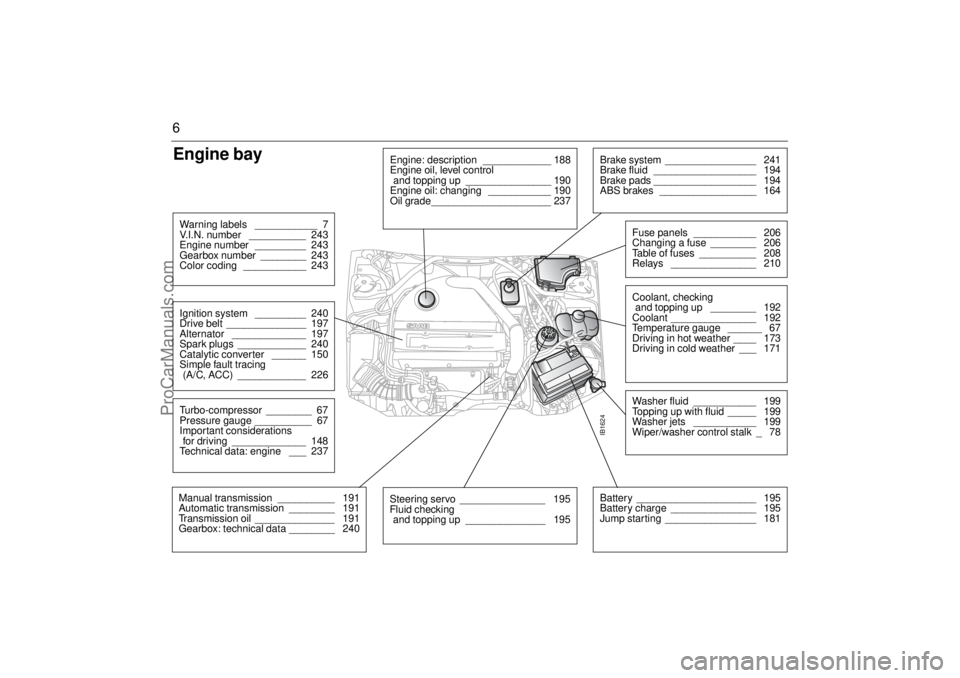
6Engine bayWarning labels ___________ 7
V.I.N. number __________ 243
Engine number _________ 243
Gearbox number ________ 243
Color coding ___________ 243Ignition system _________ 240
Drive belt ______________ 197
Alternator _____________ 197
Spark plugs ____________ 240
Catalytic converter ______ 150
Simple fault tracing
(A/C, ACC) ____________ 226Turbo-compressor ________ 67
Pressure gauge __________ 67
Important considerations
for driving _____________ 148
Technical data: engine ___ 237Manual transmission __________ 191
Automatic transmission ________ 191
Transmission oil ______________ 191
Gearbox: technical data ________ 240
Battery _____________________ 195
Battery charge _______________ 195
Jump starting ________________ 181IB1624
Engine: description ____________ 188
Engine oil, level control
and topping up _______________ 190
Engine oil: changing ___________ 190
Oil grade_____________________ 237
Washer fluid ___________ 199
Topping up with fluid _____ 199
Washer jets ___________ 199
Wiper/washer control stalk _ 78
Steering servo _______________ 195
Fluid checking
and topping up ______________ 195
Coolant, checking
and topping up ________ 192
Coolant _______________ 192
Temperature gauge ______ 67
Driving in hot weather ____ 173
Driving in cold weather ___ 171Fuse panels ___________ 206
Changing a fuse ________ 206
Table of fuses __________ 208
Relays _______________ 210
Brake system ________________ 241
Brake fluid __________________ 194
Brake pads __________________ 194
ABS brakes _________________ 164
ProCarManuals.com
Page 63 of 256
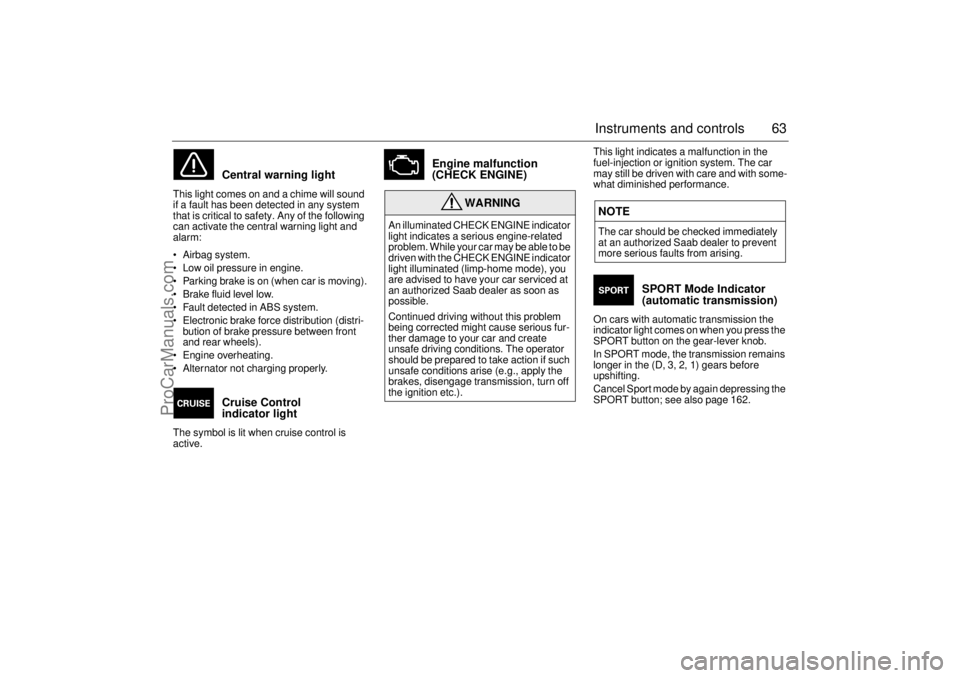
63 Instruments and controls
Central warning light
This light comes on and a chime will sound
if a fault has been detected in any system
that is critical to safety. Any of the following
can activate the central warning light and
alarm:
Airbag system.
Low oil pressure in engine.
Parking brake is on (when car is moving).
Brake fluid level low.
Fault detected in ABS system.
Electronic brake force distribution (distri-
bution of brake pressure between front
and rear wheels).
Engine overheating.
Alternator not charging properly.
Cruise Control
indicator light
The symbol is lit when cruise control is
active.
Engine malfunction
(CHECK ENGINE)
This light indicates a malfunction in the
fuel-injection or ignition system. The car
may still be driven with care and with some-
what diminished performance.
SPORT Mode Indicator
(automatic transmission)
On cars with automatic transmission the
indicator light comes on when you press the
SPORT button on the gear-lever knob.
In SPORT mode, the transmission remains
longer in the (D, 3, 2, 1) gears before
upshifting.
Cancel Sport mode by again depressing the
SPORT button; see also page 162.
WARNING
An illuminated CHECK ENGINE indicator
light indicates a serious engine-related
problem. While your car may be able to be
driven with the CHECK ENGINE indicator
light illuminated (limp-home mode), you
are advised to have your car serviced at
an authorized Saab dealer as soon as
possible.
Continued driving without this problem
being corrected might cause serious fur-
ther damage to your car and create
unsafe driving conditions. The operator
should be prepared to take action if such
unsafe conditions arise (e.g., apply the
brakes, disengage transmission, turn off
the ignition etc.).
NOTEThe car should be checked immediately
at an authorized Saab dealer to prevent
more serious faults from arising.
ProCarManuals.com
Page 73 of 256

73 Instruments and controls
The following CHECK messages may be
displayed: 1) This message will be displayed approximately
600 miles (1,000 km) before the next sched-
uled service is due, or when 365 days have
elapsed since the last service. The message
should be cleared at the time of that service
(see the Saab Warranties & Service Record
Booklet).
This message can also be deleted by first
briefly pressing the CLR button, then depress-
ing it a second time for at least eight seconds
until "SERVICE" appears on the display and a
chime sounds. The message can only be
deleted when it is shown on the SID.
Night panelTo improve night-driving conditions inside
the car, the Night Panel mode can be
selected. In this mode, the amount of infor-
mation displayed is reduced, and only the
most important instruments and displays
will be illuminated.
When the Night Panel button is pressed,
only the speedometer will be illuminated (up
to the 87-mph or 140-km/h graduation), all
the other instruments illumination will be
extinguished and their needles moved to
zero. Both the SID and the ACC displays will
be extinguished and the backlighting for
switches and other controls will be dimmed.
Note: All indicator and warning lights,
together with the display of CHECK mes-
sages, will operate as normal. The following conditions will wake up the
respective displays in the Night-Panel
mode:
Setting of the Audio System, SID or ACC
(display comes on for ten seconds).
CHECK message generated in the SID.
High engine revs cause the rev counter to
be illuminated until the engine speed has
fallen again.
If the quantity of fuel remaining falls below
4 gallons (15 liters), the fuel gauge will be
illuminated.
If the engine temperature rises above nor-
mal, the temperature gauge will be illumi-
nated.
If the speed of the car exceeds 84 mph
(135 km/h), the entire speedometer will
be illuminated.
In cars with automatic transmission, if the
selector lever is moved from D to position
3, 2 or 1, the selector indication on the
main instrument panel will be illuminated.
To restore the displays and lighting to the
normal mode, press the Night-Panel button. Display shows: See
page
BRAKE LIGHT FAILURE 202
FRONT LIGHT FAILURE 200
REAR LIGHT FAILURE 202
FOG LIGHT FAILURE 203
WASHER FLUID LEVEL LOW 199
TIGHTEN FUEL FILLER CAP 151
FILL COOLANT FLUID 192
KEY NOT ACCEPTED 45
REPLACE KEY BATTERY 45
SERVICE THEFT ALARM 45
TRANSMISSION OVERHEATING 159
TIME FOR SERVICE
1)
230
ProCarManuals.com
Page 159 of 256
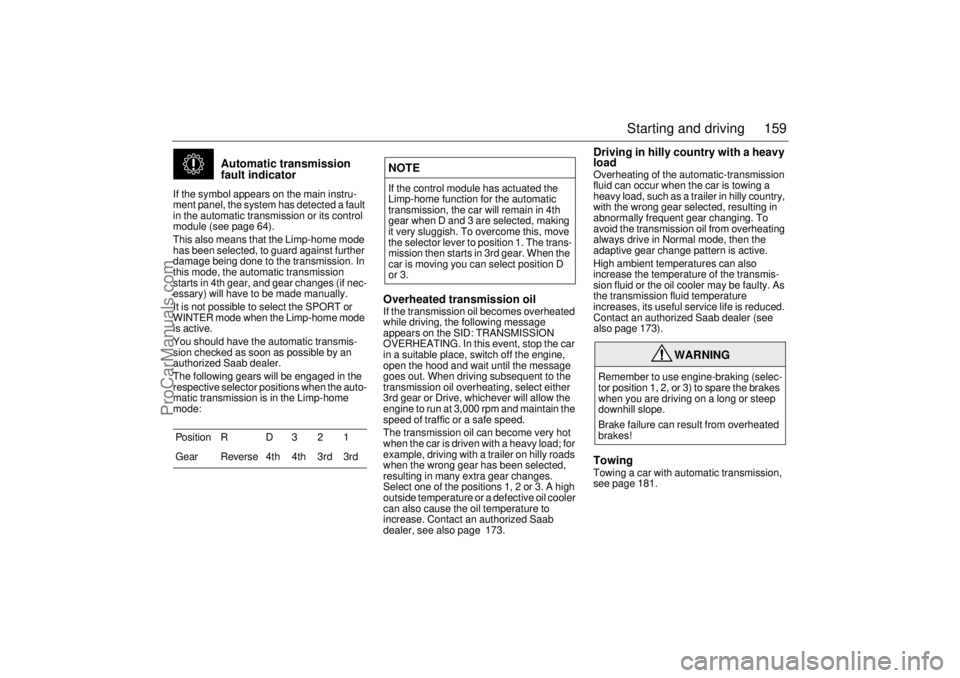
159 Starting and driving
Automatic transmission
fault indicator
If the symbol appears on the main instru-
ment panel, the system has detected a fault
in the automatic transmission or its control
module (see page 64).
This also means that the Limp-home mode
has been selected, to guard against further
damage being done to the transmission. In
this mode, the automatic transmission
starts in 4th gear, and gear changes (if nec-
essary) will have to be made manually.
It is not possible to select the SPORT or
WINTER mode when the Limp-home mode
is active.
You should have the automatic transmis-
sion checked as soon as possible by an
authorized Saab dealer.
The following gears will be engaged in the
respective selector positions when the auto-
matic transmission is in the Limp-home
mode:
Overheated transmission oilIf the transmission oil becomes overheated
while driving, the following message
appears on the SID: TRANSMISSION
OVERHEATING. In this event, stop the car
in a suitable place, switch off the engine,
open the hood and wait until the message
goes out. When driving subsequent to the
transmission oil overheating, select either
3rd gear or Drive, whichever will allow the
engine to run at 3,000 rpm and maintain the
speed of traffic or a safe speed.
The transmission oil can become very hot
when the car is driven with a heavy load; for
example, driving with a trailer on hilly roads
when the wrong gear has been selected,
resulting in many extra gear changes.
Select one of the positions 1, 2 or 3. A high
outside temperature or a defective oil cooler
can also cause the oil temperature to
increase. Contact an authorized Saab
dealer, see also page 173.
Driving in hilly country with a heavy
loadOverheating of the automatic-transmission
fluid can occur when the car is towing a
heavy load, such as a trailer in hilly country,
with the wrong gear selected, resulting in
abnormally frequent gear changing. To
avoid the transmission oil from overheating
always drive in Normal mode, then the
adaptive gear change pattern is active.
High ambient temperatures can also
increase the temperature of the transmis-
sion fluid or the oil cooler may be faulty. As
the transmission fluid temperature
increases, its useful service life is reduced.
Contact an authorized Saab dealer (see
also page 173).TowingTowing a car with automatic transmission,
see page 181. Position R D 3 2 1
Gear Reverse 4th 4th 3rd 3rd
NOTEIf the control module has actuated the
Limp-home function for the automatic
transmission, the car will remain in 4th
gear when D and 3 are selected, making
it very sluggish. To overcome this, move
the selector lever to position 1. The trans-
mission then starts in 3rd gear. When the
car is moving you can select position D
or 3.
WARNING
Remember to use engine-braking (selec-
tor position 1, 2, or 3) to spare the brakes
when you are driving on a long or steep
downhill slope.
Brake failure can result from overheated
brakes!
ProCarManuals.com
Page 184 of 256
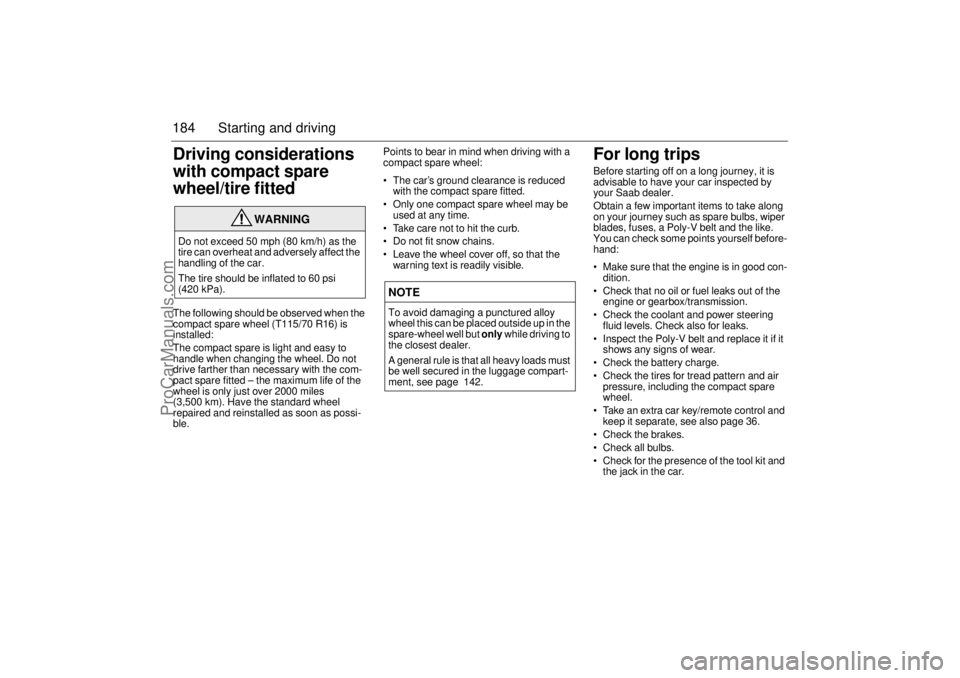
184 Starting and drivingDriving considerations
with compact spare
wheel/tire fitted The following should be observed when the
compact spare wheel (T115/70 R16) is
installed:
The compact spare is light and easy to
handle when changing the wheel. Do not
drive farther than necessary with the com-
pact spare fitted – the maximum life of the
wheel is only just over 2000 miles
(3,500 km). Have the standard wheel
repaired and reinstalled as soon as possi-
ble.Points to bear in mind when driving with a
compact spare wheel:
The car’s ground clearance is reduced
with the compact spare fitted.
Only one compact spare wheel may be
used at any time.
Take care not to hit the curb.
Do not fit snow chains.
Leave the wheel cover off, so that the
warning text is readily visible.
For long tripsBefore starting off on a long journey, it is
advisable to have your car inspected by
your Saab dealer.
Obtain a few important items to take along
on your journey such as spare bulbs, wiper
blades, fuses, a Poly-V belt and the like.
You can check some points yourself before-
hand:
Make sure that the engine is in good con-
dition.
Check that no oil or fuel leaks out of the
engine or gearbox/transmission.
Check the coolant and power steering
fluid levels. Check also for leaks.
Inspect the Poly-V belt and replace it if it
shows any signs of wear.
Check the battery charge.
Check the tires for tread pattern and air
pressure, including the compact spare
wheel.
Take an extra car key/remote control and
keep it separate, see also page 36.
Check the brakes.
Check all bulbs.
Check for the presence of the tool kit and
the jack in the car.
WARNING
Do not exceed 50 mph (80 km/h) as the
tire can overheat and adversely affect the
handling of the car.
The tire should be inflated to 60 psi
(420 kPa).
NOTETo avoid damaging a punctured alloy
wheel this can be placed outside up in the
spare-wheel well but only while driving to
the closest dealer.
A general rule is that all heavy loads must
be well secured in the luggage compart-
ment, see page 142.
ProCarManuals.com
Page 191 of 256
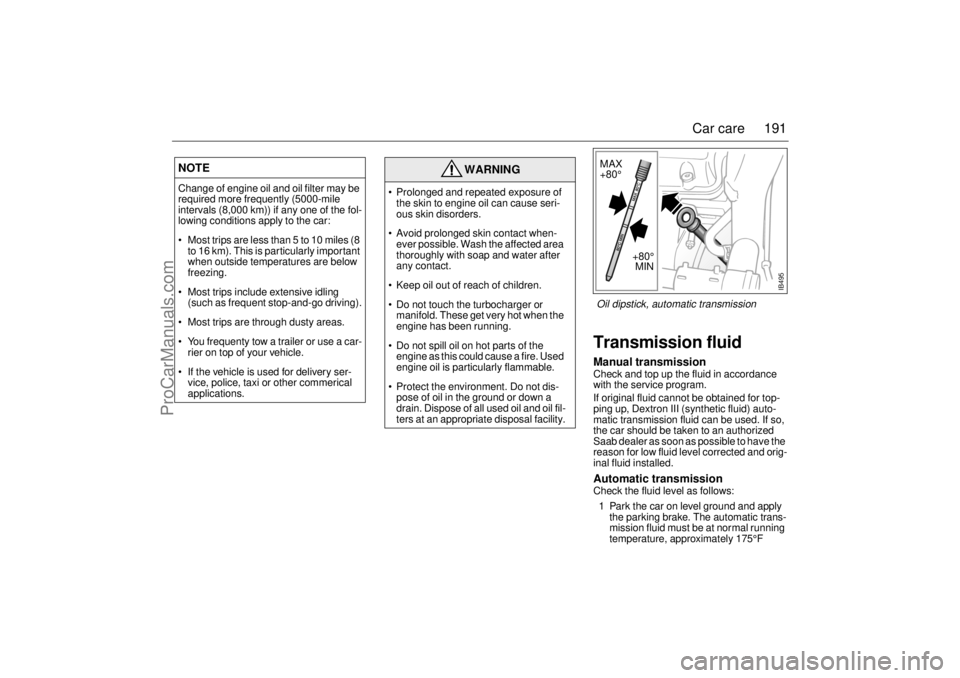
191 Car care
Transmission fluidManual transmissionCheck and top up the fluid in accordance
with the service program.
If original fluid cannot be obtained for top-
ping up, Dextron III (synthetic fluid) auto-
matic transmission fluid can be used. If so,
the car should be taken to an authorized
Saab dealer as soon as possible to have the
reason for low fluid level corrected and orig-
inal fluid installed.Automatic transmissionCheck the fluid level as follows:
1 Park the car on level ground and apply
the parking brake. The automatic trans-
mission fluid must be at normal running
temperature, approximately 175°F
NOTEChange of engine oil and oil filter may be
required more frequently (5000-mile
intervals (8,000 km)) if any one of the fol-
lowing conditions apply to the car:
Most trips are less than 5 to 10 miles (8
to 16 km). This is particularly important
when outside temperatures are below
freezing.
Most trips include extensive idling
(such as frequent stop-and-go driving).
Most trips are through dusty areas.
You frequenty tow a trailer or use a car-
rier on top of your vehicle.
If the vehicle is used for delivery ser-
vice, police, taxi or other commerical
applications.
WARNING
Prolonged and repeated exposure of
the skin to engine oil can cause seri-
ous skin disorders.
Avoid prolonged skin contact when-
ever possible. Wash the affected area
thoroughly with soap and water after
any contact.
Keep oil out of reach of children.
Do not touch the turbocharger or
manifold. These get very hot when the
engine has been running.
Do not spill oil on hot parts of the
engine as this could cause a fire. Used
engine oil is particularly flammable.
Protect the environment. Do not dis-
pose of oil in the ground or down a
drain. Dispose of all used oil and oil fil-
ters at an appropriate disposal facility.
+80°
MIN MAX
+80°
IB495
Oil dipstick, automatic transmission
ProCarManuals.com
Page 192 of 256
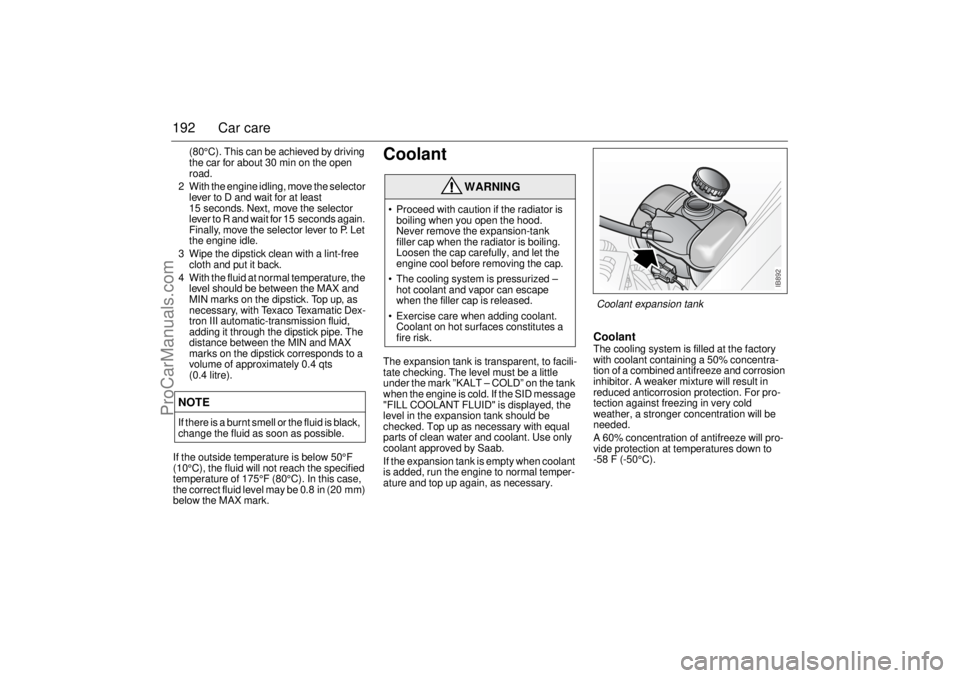
192 Car care
(80°C). This can be achieved by driving
the car for about 30 min on the open
road.
2 With the engine idling, move the selector
lever to D and wait for at least
15 seconds. Next, move the selector
lever to R and wait for 15 seconds again.
Finally, move the selector lever to P. Let
the engine idle.
3 Wipe the dipstick clean with a lint-free
cloth and put it back.
4 With the fluid at normal temperature, the
level should be between the MAX and
MIN marks on the dipstick. Top up, as
necessary, with Texaco Texamatic Dex-
tron III automatic-transmission fluid,
adding it through the dipstick pipe. The
distance between the MIN and MAX
marks on the dipstick corresponds to a
volume of approximately 0.4 qts
(0.4 litre).
If the outside temperature is below 50°F
(10°C), the fluid will not reach the specified
temperature of 175°F (80°C). In this case,
the correct fluid level may be 0.8 in (20 mm)
below the MAX mark.
CoolantThe expansion tank is transparent, to facili-
tate checking. The level must be a little
under the mark ”KALT – COLD” on the tank
when the engine is cold. If the SID message
"FILL COOLANT FLUID" is displayed, the
level in the expansion tank should be
checked. Top up as necessary with equal
parts of clean water and coolant. Use only
coolant approved by Saab.
If the expansion tank is empty when coolant
is added, run the engine to normal temper-
ature and top up again, as necessary.
Coolant The cooling system is filled at the factory
with coolant containing a 50% concentra-
tion of a combined antifreeze and corrosion
inhibitor. A weaker mixture will result in
reduced anticorrosion protection. For pro-
tection against freezing in very cold
weather, a stronger concentration will be
needed.
A 60% concentration of antifreeze will pro-
vide protection at temperatures down to
-58 F (-50°C).
NOTEIf there is a burnt smell or the fluid is black,
change the fluid as soon as possible.
WARNING
Proceed with caution if the radiator is
boiling when you open the hood.
Never remove the expansion-tank
filler cap when the radiator is boiling.
Loosen the cap carefully, and let the
engine cool before removing the cap.
The cooling system is pressurized –
hot coolant and vapor can escape
when the filler cap is released.
Exercise care when adding coolant.
Coolant on hot surfaces constitutes a
fire risk.
IB892
Coolant expansion tank
ProCarManuals.com
Page 231 of 256

231 Maintenance and owner assistance
Service record retentionService instruction coupons and record
stubs are provided in the Saab Warranties
and Service Record Booklet which accom-
panies this Owner’s Manual. The coupons
are arranged in the order that normal ser-
vice should be performed. The edge of each
coupon is shaded to correspond to the type
of service point:
Striped - "Check-up".
Blue - Oil change/inspection service.
Black - Major service.
Note that in Canada a combined service
and warranty book is used, but not service
coupons.
When scheduled services are performed,
your dealer will tear out the applicable
coupon and use it to check off the opera-
tions performed and enter it into the service
file at the dealership. The servicing dealer’s
stamp, along with the date and mileage at
which the service was done, should be
entered on the corresponding stub which
remains in your booklet. The booklet is your
permanent record of the services per-
formed. It also includes a log sheet for
unscheduled repairs.
It is advisable to retain receipts and, if pos-
sible, copies of shop work orders for all ser-
vice and repair work, wherever performed.
Service costsDealer pricing practices and labor for ser-
vice work vary. Saab’s recommended ser-
vice times for each service point do not
include the labor required to replace wear
items, such as wiper blades, brake pads or
tires. Nor is labor to perform other service or
repairs found to be necessary as a result of
the inspections included in these times.
Additional labor and parts will be charged
for such work when necessary, except as
covered under an applicable Saab warranty
or any optional extended service contract.
Transmission fluid changes or suspension
alignment, when necessary, are also addi-
tional.
Dealer charges for general shop material,
regulated hazardous waste removal, recy-
cling expenses or other operation costs may
also be applied to service and repair
invoices and are apt to vary by dealer and
location.
Owner assistanceWarranties and service problem
assistanceFor complete information about all applica-
ble warranties, including the New Car War-
ranty, Perforation Warranty, Vehicle Emis-
sion Warranty and Emission Perforation
Warranty, consult the Warranties and Ser-
vice Record Booklet which accompanies
this Owner’s Manual. It also contains owner
assistance information including Saab
Roadside Assistance. If the booklet is lost or
misplaced, a new one may be ordered
through a Saab dealer or by contacting
Saab.
In the U.S. there is a national Customer
Assistance Center at Saab Cars USA, Inc.
The toll-free number to call from all 50 states
is 1-800-955-9007.
In Canada, please call the Saab Customer
Assistance Centre at 1-800-263-1999.
A list of authorized Saab sales and service
dealers is available for those planning to
travel in the United States and Canada.
Canadian or U.S. travelers may call the
Customer Assistance Center in the country
in which they are traveling.
ProCarManuals.com
Page 247 of 256

247 Index
IndexAA/C system, fault diagnosis
________ 226
A/C system, maintenance _________ 226
ACC
__________________________ 84
ACC, useful tips
_________________ 92
Adjustment, steering wheel
________ 131
Air conditioning (A/C), fault diagnosis
and maintenance
______________ 226
Airbag
_________________________ 28
Alarm __________________________ 41
Alarm functions
__________________ 44
Alarm signals
___________________ 44
Anti-corrosion treatment
__________ 222
Anti-theft system
_________________ 41
Ashtray
_______________________ 135
Audio System
___________________ 93
Automatic climate control (ACC)
_____ 84
Automatic transmission
___________ 156
BBattery
________________________ 195
Boost starting from donor battery
___ 181
Brake fluid, check
_______________ 194
Brake fluid, grade _______________ 241
Brake pad wear indicators
___ 164
, 194
Brakes
________________________ 164Braking
_______________________164
Bulb table _____________________205
CCD changer
____________________102
CD player
_____________________100
CHECK messages
_______________72
CHECKING
_____________________72
Cabin lighting __________________133
Calibration, ACC _________________90
Car alarm
______________________41
Care of safety belts
______________218
Central locking
__________________36
Change of address notification
_____232
Changing a wheel
_______________215
Changing bulbs
_________________200
Changing the engine oil
__________190
Changing the key battery __________39
Changing the wheels round _______212
Changing wiper blades
___________198
Chassis number
________________243
Child car seats
__________________19
Child safety
_____________________19
Child safety locks, rear doors
_______39
Child seats
_____________________19
Cigar lighter ____________________135
Cleaning the soft top, Convertible
____57
Climate-control system, manual
_____80
Compact spare wheel
____________214
Condensation water, A/C __________82Condensation water, ACC
_________ 85
Convertible
____________________ 47
Coolant
______________________ 192
Courtesy Headlight Feature
_______ 76
Cruise Control
_________________ 163
Cup holder
____________________ 134
DDICE/TWICE
__________________ 207
Date code, tires ________________ 214
Dim low beam
__________________ 75
Dimmer
_______________________ 78
Direction indicators
______________ 76
Direction-indicator stalk
___________ 76
Dome lighting
_________________ 133
Door mirrors
__________________ 137
Drive belt
_____________________ 197
Driving in deep water
____________ 179
Driving in hot weather ___________ 173
Driving technique
_______________ 170
Driving with a compact spare wheel
184
Driving with a load
______________ 178
Driving with a roof load
__________ 176
Driving with the trunk lid open
_____ 179
EEconomical motoring
____________ 170
Electrical system, technical data
___ 240
Electrical window
_______________ 130
ProCarManuals.com
Page 249 of 256

249 Index
MMain beam
_____________________ 75
Main instrument panel
_____________ 60
Maintenance schedule ___________ 230
Manual climate-control system
______ 80
Manual raising of the soft top,
Convertible
____________________ 52
Manual transmission
_____________ 155
Manually opening the fuel filler door,
Convertible
____________________ 58
Manually opening the fuel filler door,
Coupé and 5-door
______________ 144
Maxi fuses
_____________________ 207
Memory, driver’s seat
____________ 128
Motoring abroad
________________ 184
NNight Panel
_____________________ 73
OORVR
________________________ 189
Odometer ______________________ 66
Oil specification
_________________ 237
OnStar
________________________ 111
Opening handle
__________________ 36
Owner assistance _______________ 231
PPaint touch-up
__________________221
Parcel shelf
____________________141
Park Brake Shift Lock
____________158
Parking brake
__________________168
Parking lights ____________________75
Plates and labels
________________243
Power steering fluid, check
________195
Power steering oil, grade
_________241
Pressure gauge
__________________67
Programmable driver’s seat
_______128
Programming, ACC
_______________90
RRadio
__________________________98
Raising the soft top, Convertible
_____51
Rear fog light
____________________77
Rear seat
______________________138
Rear seat, tipping
_______________138
Rearview mirrors ________________137
Rear-window wiper _______________79
Recirculation
____________________82
Recycling
______________________224
Refuelling _____________________151
Relay table ____________________209
Release handle, hood
____________186
Remote control
__________________36
Remote control battery, changing
____39
Removing the key
_______________146
Reporting safety defects
__________232Rev counter
____________________ 66
Reversing lights
_________________ 77
Roof rack
_____________________ 176
Rotating the tires
_______________ 212
Running-in
____________________ 155
SSAHR, head restraint
____________ 18
SID (Side Instrument Display)
______ 69
SRS (airbag)
___________________ 28
Saab Audio System
______________ 93
Saab Trionic engine management
system
______________________ 189
Safety belts ____________________ 12
Safety belts, care of
_____________ 218
Seat belts
_____________________ 12
Seat-belt pretensioners
___________ 13
Seats
________________________ 124
Service costs
__________________ 231
Service information
_____________ 232
Service intervals
_______________ 230
Service record retention
_________ 231
Side airbags
___________________ 30
Ski hatch
_____________________ 141
Snow tires ____________________ 242
Soft top storage, Convertible
_______ 56
Spare wheel
__________________ 143
Speedometer ___________________ 66
Starting the engine
_____________ 147
Steering-wheel adjustment
_______ 131
ProCarManuals.com